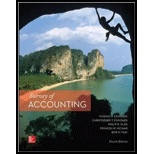
Survey Of Accounting
4th Edition
ISBN: 9780077862374
Author: Edmonds, Thomas P.
Publisher: Mcgraw-hill Education,
expand_more
expand_more
format_list_bulleted
Textbook Question
Chapter 7, Problem 18Q
2. At the beginning of Year 1, B Co. has a note payable of $72,000 that calls for an annual payment of $16,246, which includes both principal and interest. If the interest rate is 8 percent, what is the amount of interest expense in Year 1 and in Year 2? What is the balance of the note at the end of Year 2?
Expert Solution & Answer
Want to see the full answer?
Check out a sample textbook solution
Students have asked these similar questions
Can you solve this general accounting question with the appropriate accounting analysis techniques?
answer to below Question
Spark Industries estimates that overhead costs for the next year will be $3,950,000 for indirect labor and $780,000 for factory utilities. The company uses machine hours as its overhead allocation base. If 120,000 machine hours are planned for the next year, what is the company's plantwide overhead rate?
Chapter 7 Solutions
Survey Of Accounting
Ch. 7 - 1. What type of transaction is a cash payment to...Ch. 7 - Prob. 2QCh. 7 - How does recording accrued interest affect the...Ch. 7 - 4. Who is the maker of a note payable?Ch. 7 - How does the going concern assumption discussed in...Ch. 7 - 6. Why is it necessary to make an adjusting entry...Ch. 7 - Prob. 7QCh. 7 - Prob. 8QCh. 7 - Prob. 9QCh. 7 - Prob. 10Q
Ch. 7 - 11. Are contingent liabilities recorded on a...Ch. 7 - Prob. 12QCh. 7 - Prob. 13QCh. 7 - Prob. 14QCh. 7 - Prob. 15QCh. 7 - Prob. 16QCh. 7 - 1. What is the difference between classification...Ch. 7 - 2. At the beginning of Year 1, B Co. has a note...Ch. 7 - 3. What is the purpose of a line of credit for a...Ch. 7 - 4. What are the primary sources of debt financing...Ch. 7 - 5. What are some advantages of issuing bonds...Ch. 7 - 6. What are some disadvantages of issuing bonds?Ch. 7 - 7. Why can a company usually issue bonds at a...Ch. 7 - 15. If Roc Co. issued 100,000 of 5 percent,...Ch. 7 - 16. What is the mechanism is used to adjust the...Ch. 7 - 17. When the effective interest rate is higher...Ch. 7 - 18. What type of transaction is the issuance of...Ch. 7 - 19. What factors may cause the effective interest...Ch. 7 - 20. If a bond is selling at 97, how much cash will...Ch. 7 - Prob. 30QCh. 7 - 22. Gay Co. has a balance m the Bonds Payable...Ch. 7 - Prob. 32QCh. 7 - Prob. 33QCh. 7 - Prob. 1ECh. 7 - Prob. 2ECh. 7 - Prob. 3ECh. 7 - Prob. 4ECh. 7 - Prob. 5ECh. 7 - Prob. 6ECh. 7 - Prob. 7ECh. 7 - Prob. 8ECh. 7 - Prob. 9ECh. 7 - Prob. 10ECh. 7 - Prob. 11ECh. 7 - Prob. 12ECh. 7 - Prob. 13ECh. 7 - Prob. 14ECh. 7 - Prob. 15ECh. 7 - Prob. 16ECh. 7 - Prob. 17ECh. 7 - Prob. 18ECh. 7 - Prob. 19ECh. 7 - Prob. 20ECh. 7 - Prob. 21ECh. 7 - Prob. 22ECh. 7 - Prob. 23ECh. 7 - Prob. 24ECh. 7 - Prob. 25ECh. 7 - Prob. 26PCh. 7 - Prob. 27PCh. 7 - Prob. 28PCh. 7 - Prob. 29PCh. 7 - Prob. 30PCh. 7 - Prob. 31PCh. 7 - Prob. 32PCh. 7 - Prob. 33PCh. 7 - Prob. 34PCh. 7 - Prob. 35PCh. 7 - Prob. 36PCh. 7 - Prob. 37PCh. 7 - Prob. 38PCh. 7 - Prob. 1ATCCh. 7 - Prob. 4ATCCh. 7 - Prob. 5ATC
Knowledge Booster
Learn more about
Need a deep-dive on the concept behind this application? Look no further. Learn more about this topic, accounting and related others by exploring similar questions and additional content below.Similar questions
- Please provide the accurate answer to this financial accounting problem using appropriate methods.arrow_forwardI am searching for the accurate solution to this general accounting problem with the right approach.arrow_forwardHow much lower would kite net income be if it used variable costing instead of absorption costing ?arrow_forward
- Kepler Manufacturing has $18,000 of ending finished goods inventory as of December 31, 2023. If beginning finished goods inventory was $8,000 and the cost of goods sold (COGS) was $55,000, how much would Kepler report for cost of goods manufactured?arrow_forwardMosco Industries manufactures a single product and follows a JIT policy where ending inventory must equal 20% of the next month's sales. It estimates that November's ending inventory will consist of 32,000 units. December and January sales are estimated to be 210,000 and 225,000 units, respectively. Mosco assigns variable overhead at a rate of $2.85 per unit of production. Fixed overhead equals $375,000 per month. Compute the number of units to be produced and the total budgeted overhead that would appear on the factory overhead budget for the month of December.arrow_forwardCan you explain this general accounting question using accurate calculation methods?arrow_forward
arrow_back_ios
SEE MORE QUESTIONS
arrow_forward_ios
Recommended textbooks for you
- Principles of Accounting Volume 1AccountingISBN:9781947172685Author:OpenStaxPublisher:OpenStax College

Principles of Accounting Volume 1
Accounting
ISBN:9781947172685
Author:OpenStax
Publisher:OpenStax College
7.2 Ch 7: Notes Payable and Interest, Revenue recognition explained; Author: Accounting Prof - making it easy, The finance storyteller;https://www.youtube.com/watch?v=wMC3wCdPnRg;License: Standard YouTube License, CC-BY